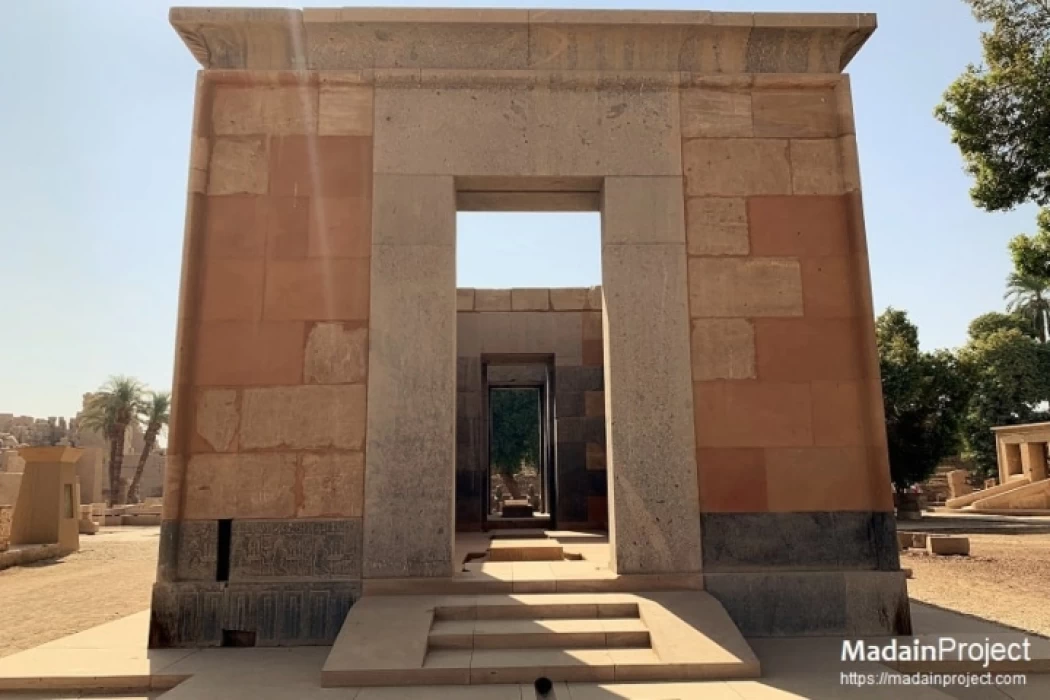
The Red Chapel of Hatshepsut
The Red Chapel in Karnak, or the Red Chapel of Hatshepsut, is a relatively small hall established by Queen Hatshepsut in the temple of Karnak in Luxor to worship and preserve the divine compound of the god Amun. This chapel is a small part of the Karnak Temple complex. The chapel is built of red quartzite and black granite stones, which form the base of the chapel.
Introduction
During the excavation, 319 stone fragments of black granite and red quartzite were found on the site. The use of these stones in the past to fill voids in some of the other large pharaonic monuments, the stones have preserved valuable drawings engraved on them and testify to the era of prosperity during the new kingdom, especially during the reign of Hatshepsut. The chapel was rebuilt during the end of the twentieth century AD in the Karnak Temple.
Construction and uses of the chapel
Queen Hatshepsut established the chapel in front of the Karnak Temple built to worship the god Ra in Thebes (now Luxor), which was still small during the Middle Kingdom. The paintings inside the chapel show Hatshepsut wearing the reins of government as one of the men, she was even depicted with a beard. She is not identified as Queen Hatshepsut except by her name accompanying these drawings.
Then King Thutmose III demolished Hatshepsut's Chapel in the 23rd year of his reign and replaced it with a building for the celebration and preservation of the divine boat, which he built himself. When Amenhotep III ruled Egypt, he used the stones of Hatshepsut's chapel as materials to fill the structure of the third edifice in the temple of Amun-Ra.
The feast of Opet in the reign of Hatshepsut
Hatshepsut declared the celebration of opet for the first time in 1462 BC and fixed it on the 14th day of the second month of the separation of a sister. Paintings in the Red Chapel attest to this celebration, as well as a full description of the rituals of this holiday in the temple of the maritime Monastery of Hatshepsut, which is dedicated to the "divine birth" of Hatshepsut as the daughter of the god Amun. It is mentioned in this description:
This great god Amun became the king of the throne, where he formed himself and approached her as the ruler of Upper Egypt and Lower Egypt (AA-khbar-ka-Ra ʿ3-ḫpr-K3-Rʿ), and she is the beautiful one in her palace. She woke up from her sleep when she was touched by his beautiful wind and smiled at him, so he approached her and was inclined to nest her and gave her his heart, and allowed her to see him in the form of the divine after he came to her. She was glad to see his beauty, and his love filled her body. And the palace was filled with the intelligent scent of God, and all his smells were from the smells of a "girlish" country. And enjoy her beauty and let him enjoy her. And I kissed him.
Hatshepsut created this legend by marrying Amun to baptize her as Queen of Egypt after the early death of her husband Ahmose II, as the accession to the throne was limited to males from the royal family.
Red Chapel Records
On the outer wall of the Red Chapel, there are records in the form of painted and written paintings, which are divided only by several records according to the occasion and the themes they express.
Chronicle 1: mentions the provinces of Egypt during the reign of Hatshepsut, the contents of the temple, religious processions
Record 2: prayer and consultation of the gods (to find out the future), the processions of the feast of Opet and the feast of the valley, and the procession of moving from Luxor to Deir el Bahri and back.
Chronicles 3 - 5: the ceremonies of the feast of the opet and the feast of the valley, the procession of the transition from Thebes to Deir el-Bahri across the Nile and back،
Chronicle 6: offerings, preparations for the coronation ceremonies, offerings made to the Holy Ninth of Heliopolis.
Record 7: coronation ceremonies،
Chronicle 8: celebrations with the participation of Thutmose III
Reconstruction of the Red Chapel
Many of the stones that formed the Red Chapel of Hatshepsut were found during the Fifties of the last century, some of them were found in a monument to King Amenhotep III. A group of Egyptian and French archaeologists managed to find out the original shape of the chapel until 1997. It was later recreated and contains about 300 of the original stones arranged according to the themes and events that express them and can be viewed in the open-air museum located in the square of the Karnak Temple in Luxor.














